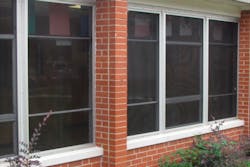Security screens provide additional layer of protection for K-12 entries
Windows and glass doors are among the most vulnerable access points in a school. Criminals can break glass to climb through or reach in and unlock the entry. The security industry has responded with two solutions to slow down a criminal looking to break into a school building.
One solution is window film that’s applied directly to glass to make it more difficult to break. This product has been on the market for years, but now is available with up to 42 micro-layers of strong, tear-resistant safety film. These films can significantly slow a criminal armed with a hammer or other heavy tool from breaking through glass. As an added benefit, window film is designed to hold onto broken glass reducing the possibility of injury or damage caused by flying glass shards.
Glass on thousands of K-12 facilities is now protected with window film. Anything that delays a criminal from gaining access to his target is a good thing, but that doesn’t make it the best choice for every situation.
Active shooters rarely carry hammers in their arsenals. High-powered handguns, assault rifles and specialty ammunition are usually a shooters’ standard choice of weapons. These weapons are game changers as administrators seek to harden school entries. The front doors at Sandy Hook Elementary were properly locked, but the gunman entered by shooting through an unprotected glass panel. Security film on the glass would have minimally slowed the gunman, who was armed with a Bushmaster semi-automatic rifle.
This video shows how a man armed with a relatively low-powered .38-caliber handgun can shoot through window film, push aside the shattered glass and open a door.
A more secure choice for protecting glass is window screens, which provide an almost impenetrable barrier, capable of withstanding attacks by hammers, knives and even assault rifles. Here’s another video demonstrating the protection offered by security screens.
Security screens don’t stop bullets, but resist further cutting, tearing or blunt force attacks making it almost impossible to create an opening large enough to reach through and unlock a door or window.
Dan Guthrie, owner of Harmony Security Products based in Emigsville, Penn. sells both window film and security screens. He said screens are slightly more expensive, but that the cost difference shrinks as additional doors and windows are added to a job.
“It’s all about creating a physical barrier that prevents intruders from entering a school long enough for first responders to arrive.” Guthrie said. “Security screens are more difficult to penetrate than window film — especially if the intruder is using a high-powered assault rifle. Screens are also more noticeable than film, allowing them to also act as a deterrent.”
Guthrie said screens are available in either stainless steel wire mesh or 18-gauge perforated stainless steel and are attached to doors and windows with tamper-proof screws. Security screens don’t hinder the normal operation of doors and windows and when painted black, screens present a dark, tinted look from the outside, but allow for almost clear vision from inside a school.
Urban schools were the first to adapt security screens, with suburban and rural campuses now beginning to request them, Guthrie said. Colleges and universities also use the screens, particularly on dormitories to help reduce security incidents.
Admittedly, some people are more comfortable with the film solution, he said. Variations of it are commonly used in residential and commercial locations and automobiles to reduce heat and damage from sunlight. There is also a perception among some that screens make a school resemble a prison. Yet security screens are really just a more robust version of those commonly found on many residential doors and windows.
Security screens don’t have to be placed on all campus windows, but I recommend them for all glass doors and panels. They are also a good choice for windows on remote or temporary classroom facilities where students may have fewer places to hide and find shelter during an attack by an active shooter. The added protection is worth the small premium in price.
Screens aren’t intended to replace other critical layers of security at potential entry points, but rather add another layer of safety. Door and window locks remain critical, as well as video intercoms which enable office staff to remain safely behind locked doors while viewing and talking to visitors before allowing them entry.
When it comes to protecting against an active shooter, it’s all about delaying him from reaching students and staff. Security screens provide a highly effective additional barrier giving first responders more time to respond and take control of an emergency situation.
About the Author: Patrick V. Fiel, Sr., is an independent security consultant and founder of PVF Security Consulting. He has previously served as public safety advisor for a large national security integrator; executive director of security for the Washington, D.C. Public School System; and is retired from the U.S. Army Military Police Corps.



